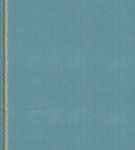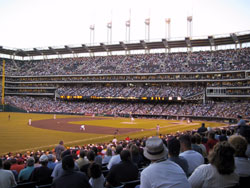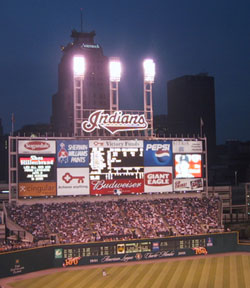 |
 |
|
|
|
|
|
|
|
|
|
|
|
|
|
|
|
|
|
|
|
|
 |
|
Sox On The Road: Cleveland
I arrived at Jacobs Field on Tuesday, August 28 as the Red Sox began their toughest stretch of the season - 13 games in 14 days against the Indians and Yankees. The team came to Ohio with a 71-58 record. In their previous series at the Jake July 3-5, Boston won two out of three, and to do so this time would give the team 73 wins.
Since Jacobs Field, with a seating capacity of 43,368, opened in 1994 it has become synonymous with the Indians winning in front of sell out crowds. But the 2000 team was the first to not advance to the playoffs since their move from old Municipal Stadium and that apparently has slightly dampened the fans' enthusiasm. Much to my surprise, there were tickets available to each game of the series. While the three games drew near-capacity crowds, averaging 40,955, none were actually sold out and empty seats were visible in the top portions of the upper deck in right field. Yes, there were actually empty seats in Cleveland during a Red Sox series not played in Municipal Stadium. Part of this was because the first game of the series coincided with the first day of school in the Cleveland metropolitan area. Another factor was that the series was in the middle of the week. But most importantly, I happened to make my first trip to the joint dubbed The Jake during the 2001 season. After selling out every home game since June 7, 1995 - a MLB record 455 straight games - a non-capacity crowd attended the Tribe's April 4 game against the White Sox. The streak shattered the previous record of 203 by the Colorado Rockies. In a fitting tribute, the team retired the number 455 above the words "The Fans" in right field alongside the team's other retired numbers. In the past, the entire season's supply of tickets would be sold out before the season started. Local fans told me that there was a lottery system held around Thanksgiving at Ticketmaster where fans were issued a non-transferable bracelet that was brought back the following day to purchase tickets.
This feat was accomplished by calling the team trying to find handicap accessible seating so I could take my grandfather to the first game. After leaving a message with the appropriate department in the front office, a man with the team called back on August 9 to give me the best two seats possible for the first game, and I went ahead and bought a ticket from him for the other two games. Although the barrier to acquiring tickets was removed due to a disappointing 2000 season, the host team was playing with the pizzazz to land them back in the playoffs come October. One the flip side, by the time the first game of the series began on Tuesday the reality of the Red Sox' playing more than 162 games seemed like a pipe dream. For starters, the triumphant return of Nomar Garciaparra was about to be expunged. Nomar had an MRI taken on his sore right wrist and Mike Lansing would be the starting shortstop. As it would turn out, Garciaparra's last game of the season had occurred in the team's previous series in Texas. On the field the news wasn't much better when the Indians scored four runs in the second inning. David Burba, who had been demoted to the bullpen earlier in the month, went on to pick up his first win in over a month, allowing only one run in seven innings. Burba gave way to bullpen refugee John Rocker, known in Cleveland for his on the field struggles. Rocker retired only two batters in the eighth, as he walked three and allowed Jose Offerman to score on one of his two wild pitches. Fortunately for the Tribe, Rocker has been relegated to mop-up duty and his control problems didn't affect the game's outcome. Rocker had a cult following in Atlanta and was adored by the Leonard Skynard crowd at Turner Field, but Cleveland fans booed him off the mound. Nonetheless, the Indians won the game 8-3. While the outcome of the game wasn't to my liking, my initial Jacobs Field experience helped make up for the loss. As I stated earlier, my 80-year old grandfather was in attendance with me on the first night. We were able to park in the garage located behind the left field foul pole on Ontario Street and made the walk from the car to our seats in less than ten minutes. Our field level seats down the line in left were easily assessable and like all of the newer stadiums, offered excellent sightlines. With ballparks such as Jacobs Field, you want to be at the game rather than watch it on TV. As it turned out, the man who sang the national anthem sat behind us, his tickets courtesy of the team. On Wednesday I immersed myself in the Jacobs Field experience, starting with a one-hour tour of the ballpark at 1 pm. For $6.50 I was part of a small group that saw parts of the stadium normally off-limits to fans as we were taken into the Indians dugout and allowed out onto the dirt warning track that surrounds the field. I saw the indoor batting cages where players can take extra cuts before, during, and after the game. We also made a trip to the press box and were taken into a posh club level suite. Although the suites had been sold out for years, there were some left this year and they were available on a game by game basis. Why anybody would rather sit on a couch and watch the game on TV while in the stadium makes no sense to me. I'd rather stand out on the Pepsi Home Run Porch in left field than be cooped away from the crowd.
When I was buying my tickets I had hoped to sit in the area directly below the stadium's most striking feature, the left field scoreboard, but those tickets sell out the quickest, despite their $17-19 price range. The monstrous scoreboard with the scripted "Indians" logo atop spans the entire six sections of the bleachers. A Jumbotron in the truest sense, at 120 feet high by 220 feet wide the scoreboard was the big league's biggest until Detroit's Comerica Park copied the feature and made theirs slightly bigger.
Another thing you quickly notice are the shapes of the light towers. While they look like toothbrushes, they are supposed to resemble the smoke stacks of Cleveland's industrial zone and the high-rise office buildings of downtown. The exposed steel design of The Jake's exterior is a feature designed to match that of the many bridges in the area, a tribute to Cleveland's title as the City of Bridges. The game held on August 29th also happened to be the date that Cleveland paid homage to the Red Sox-Indians rivalry by issuing an American League Charter Member Coin to the fans in attendance. The coin was the final installment in a series of three that celebrated the four charter members that have remained with the American League for the duration of the it's 100-year history. The front side of the coin is inscribed with the Red Sox and Indians logos and the words American League Charter Member Coin Series and August 29, 2001. The other side features the dates 1901-2001, the words 100th Anniversary Cleveland Indians, and the four charter members: Indians, Red Sox, White Sox, and Tigers. The game itself was the best of the series as rookie left-handers Casey Fossum and C.C. Sabathia matched up. The Red Sox took a 1-0 lead on a Manny Ramirez home run in the fourth, but the Indians did one better when Juan Gonzales and Ellis Burks hit back-to-back solo shots in the sixth to give the Indians a 2-1 lead. With the score the same in the ninth, the Red Sox began a rally against Cleveland closer Bob Wickman when Dante Bichette lead off with a double, but with runners on first and third and one down Jose Offerman struck out. When pinch-hitter Scott Hatteberg walked, Trot Nixon came to the plate with the bases loaded and two outs -- baseball nirvana -- before hitting into a game-ending force out. But I will always remember this game because, pardon the lack of proper prose, I was able to do one of the coolest things a baseball fan could ever have an opportunity to do. While I consider it a rare occurrence to catch a foul ball, which I did not do, it never occurred to me that I'd have an opportunity to do an inning of play-by-play from the actual broadcast booth. But that's exactly what I did. In an experience I'll never forget, I participated in the Indians FanCast Booth, which I found out about during the press box section of my Jacobs Field tour earlier in the day. The booth is located behind home plate among the other broadcasters (ESPN was three booths down), but is reserved for fans to call the action. The cost is $30 for one person, or $40 for two if you have a friend that wants to do the color commentary. The proceeds benefit the Cleveland Indians Charities. The FanCast Booth didn't appear to be well advertised. Although there was an ad in the Indians "Game Face" program, it gave little details other than a phone number. When I called to check availability around 2:30 there were still four innings open for the game, and I was able to sign up to announce the fourth inning. They asked me to arrive in a designated section in right field in the third inning from where I was escorted to the elevator behind home plate. Although the security guard temporarily confiscated my Red Sox hat, I was taken to the press level where I would have an opportunity to participate in the action while I observed it. As it turned out, the fourth inning proved to be one of the most dramatic of the series, as Manny Ramirez, loudly booed each time he stepped to the plate in the series, connected for his first home run at Jacobs Field as a visitor. Here's a text transcript of my call: " . . . the 1-0 to Ramirez is ripped into left field . . . and a scoreless ballgame no longer, welcome back to Cleveland Manny Ramirez! 1-0 Red Sox. The fans fight for it out in left field. Sabathia threw a fastball up and Ramirez tagged it. There was no doubt about that one. Boston has a 1-0 lead amidst a chorus of boos here at Jacobs Field as Ramirez points skyward a la Carl Everett."I worked solo, providing both the play-by-play and color commentary. Before taking to the microphone I was given a copy of the press notes for both teams, but I never had the time to read the information so I worked off the top of my head. Despite being in the both for nearly 30 minutes it was amazing at how fast the time flew by. After I completed my inning I received an audiocassette and videotape of my performance, with the video feed coming from Fox Sports.
The number to call to set up your inning is 216-420-4382. Although I had no trouble getting an inning, the next night's game was already booked, and reservations are usually required. But like the sellout streak being snapped, it's possible that the locals have already had their fill, giving out-of-towners a chance to participate in this unique feature. As a matter of fact, the duo that I preceded into the both were both Red Sox fans. Following the activities of the previous night, Thursday's game lacked some of the thrills that I had experienced. Unfortunately, the game's result was the same as the Indians completed their first sweep of Boston since 1996 with a 3-1 win. The Red Sox had two men on in the ninth with two out when Wickman got Ramirez to fly out to end the game. The inning was typical of the game, as Boston outhit Cleveland 12-6. For the series the Red Sox were an anemic 1-for-23 with men in scoring position. I was one of the last people to leave the stadium, soaking in the ambience of The Jake for a few extra minutes. Afterwards, I walked around the stadium and noticed that there is a cemetery directly across the street from Jacobs Field on the first base side. From there I made the 15-minute walk to The Flats, Cleveland's hip party section of restaurants and nightclubs located on the banks of the Cuyahoga River. I didn't spend too much time at the flashy and trendy area before heading back to my car. As for parking, I paid varied amounts for all three games. It seems as though no two places charged the same rate. When I was with my grandfather the first night we paid $10 in an Indians-run garage a few steps away from the ballpark's entrance. The next day I parked further away, towards the west and the Cuyahoga River, and paid $7.25. On Thursday I parked about the same distance away as I did the night before, but this time I parked to the east of the ballpark and found a lot for only $3. As for food, there are plenty of street vendors throughout downtown Cleveland where you can get a $1 hot dog and that's where I filled up. Later on my trip I also found the same vendors and prices outside of Yankee Stadium and Camden Yards, which is a far cry from the $4 sausages outside of Fenway. But after being used to going to games in Atlanta and Tampa Bay, where there are no hot dog stands outside the stadium, I appreciated the additional contribution to the baseball atmosphere as much as the low prices. A particularly refreshing item about the sports stadiums in Cleveland are their names. It seems that every city now has at least one of their baseball, football, or hockey/basketball arenas named after a big-bucks corporate sponsor, but not in Cleveland. Jacobs Field was named after previous Indians owner Richard Jacobs while the Gund Arena, home to the NBA's Cavaliers, is named after the Cavs owner. The newest addition to Cleveland is the NFL home of the Browns, which retained the simple name of Cleveland Browns Stadium. The Browns' new digs replaced the Indians' former home, Municipal Stadium, on the shores of Lake Erie. The 74,483-seat "Mistake by the Lake" was built as a part of the city's bid for the 1932 Olympics, but very little world-class baseball was played in Cleveland until the team moved to Jacobs Field, which is closer to the Cuyahoga River than the Great Lake. In addition to Gund Arena, located a long home run away behind left field, The Jake marked the beginning of the revitalization of the downtown Cleveland area, changing the fortunes of the baseball team in the process. Since 1994 the team once parodied in the movie "Major League" has been able to "Deliver by the River," replacing the mistakes by the lake with championships by the Cuyahoga. And while that spells good news for Indians fans, it meant disaster for the Red Sox: their August 28-30 trip to The Jake will be remembered as the turning point that soured the team's 2001 season.
|




